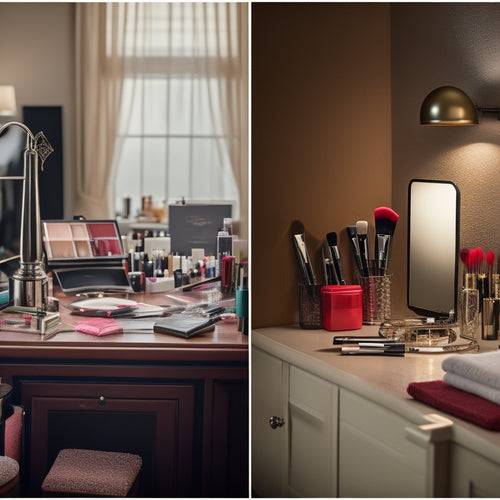
7 Time-Saving Hacks for Makeup Artists' Schedules
Share
You're a makeup artist struggling to manage your time, juggling multiple clients and tasks. To maximize your schedule, start by implementing time blocking, where you allocate specific time slots for tasks and prioritize your most productive hours. Then, use a color-coding system to categorize clients and streamline your schedule. Batch similar tasks together to save time, and strategically prioritize your makeup sessions. These hacks will help you stay on top of your busy business. Now, take the next step to optimize your schedule and transform your makeup artistry business.
Key Takeaways
• Streamline your schedule by allocating dedicated time blocks for tasks, reducing procrastination and boosting productivity.
• Implement a color-coding system to categorize clients, reducing no-shows and preparing you for each session.
• Prioritize makeup sessions strategically, allocating sufficient time for complex looks and identifying high-maintenance clients.
• Batch similar tasks into focused blocks of time, eliminating repetitive setup and teardown, and increasing productivity.
• Create detailed client profiles and session templates to set reminders and notifications, ensuring a smooth and organized schedule.
Mastering Time Blocking Essentials
By streamlining your schedule with time blocking, you'll carve out dedicated chunks of time for each task, slashing procrastination and boosting productivity. As a makeup artist, your time is valuable, and allocating it wisely is essential to delivering exceptional services to your clients.
Effective time allocation involves identifying your priorities and allocating specific time slots for each task. This is where priority setting comes in – determining which tasks require immediate attention and allocating your most productive hours to tackle them.
Color-Coding Client Appointments
As a makeup artist, you know that managing multiple client appointments can be overwhelming. To streamline your schedule, you'll want to implement a color-coding system that categorizes your clients by type, such as weddings, editorial, or special occasions.
Organizing Client Sessions
You can streamline your schedule and reduce no-shows by assigning a unique color to each client type, categorizing appointments by services offered, such as bridal, special effects, or everyday looks. This visual approach helps you quickly identify the type of service and client needs, ensuring you're prepared for each session.
To take your organization to the next level, consider implementing the following strategies:
-
Create detailed client profiles to store essential information, such as contact details, service history, and preferences.
-
Develop session templates for frequently booked services, allowing you to easily duplicate and customize appointments.
-
Set reminders and notifications for upcoming appointments, ensuring you stay on track and clients receive timely confirmations.
- Review and update your schedule regularly to identify patterns, optimize your time, and make data-driven decisions for your business.
Visual Calendar Management
Color-coding client appointments on your calendar enables you to visually distinguish between different client types, services, and priority levels, allowing for a more efficient allocation of your time and resources. This visual hierarchy helps you prioritize tasks and allocate resources effectively, giving you a digital overhaul of your scheduling system.
| Client Type | Color Code | Priority Level |
|---|---|---|
| Bridal Party | Pink | High |
| Special Occasion | Yellow | Medium |
| Everyday Look | Blue | Low |
By categorizing your clients using a color-coding system, you can quickly identify the type of service, priority level, and allocated time for each appointment. This visual calendar management system enables you to:
** Identify potential scheduling conflicts and allocate resources accordingly
**Prioritize high-priority clients and services
- Allocate sufficient time for each appointment, ensuring a smooth workflow
Prioritizing Makeup Sessions Strategically
Your makeup schedule can be optimized by categorizing clients into high-priority and low-priority sessions, ensuring that you allocate sufficient time for complex or high-maintenance looks. This strategic approach allows you to manage your Session Flow efficiently, ensuring that you're prepared for even the most demanding clients.
To prioritize your sessions effectively, follow these steps:
-
Tier your clients: Identify high-maintenance clients who require more time and attention, and schedule them accordingly.
-
Flag urgent bookings: Identify Rush Hour or Busy Seasons when you're likely to receive a surge in bookings, and plan your schedule accordingly.
-
Use priority flags: Label each session with a priority flag, indicating the level of complexity or time required, enabling you to allocate your time wisely.
- Leave buffers: Leave strategic buffers between sessions to accommodate unexpected delays or last-minute requests, ensuring a smooth and efficient workflow.
Batching Similar Tasks Efficiently
By grouping similar tasks, such as consultations, applications, or retail transactions, into focused blocks of time, you can eliminate repetitive setup and teardown, streamlining your workflow and accessing significant time savings.
This task clustering approach enables you to tackle similar tasks in one session, reducing shift time and increasing productivity.
For instance, allocate a specific time slot for all your consultations, and complete them back-to-back. This routine consolidation strategy allows you to maintain a consistent mindset and momentum, ensuring you're more efficient and effective.
Scheduling Break Times Wisely
Optimizing break times is essential to maintaining your energy and focus, as strategically placed pauses can help you recharge and return to your tasks with renewed vigor. As a makeup artist, you understand the importance of staying focused and energized throughout your busy schedule.
To make the most of your break times, follow these tips:
-
Set break reminders: Schedule regular breaks into your calendar to guarantee you take time to rest and recharge. Set reminders to take a 10-15 minute break every hour to stretch, move around, and refresh your mind.
-
Prioritize self-care routines: Use your break times to incorporate self-care routines, such as meditation, deep breathing exercises, or a quick skincare routine. This will help you relax and refocus.
-
Take a walk: Use your breaks to get some fresh air and take a short walk outside. This will help increase oxygen flow to your brain and reduce fatigue.
- Stay hydrated: Drink plenty of water during your breaks to maintain hydration and alertness. Avoid sugary drinks and caffeine that can lead to energy crashes later.
Eliminating Unnecessary Overlap
During a typical workday, you likely juggle multiple clients, appointments, and tasks, which can lead to unnecessary overlap and inefficiencies if not managed properly. To eliminate unnecessary overlap, it's essential to conduct an overlap analysis to identify areas where you can streamline your schedule.
| Task | Time Allocation |
|---|---|
| Client Consultations | 30 minutes |
| Makeup Applications | 1 hour |
| Break Times | 15 minutes |
| Travel Time | 30 minutes |
| Admin Tasks | 1 hour |
Maximizing Downtime for Growth
You can turn what would otherwise be idle time into opportunities for growth by leveraging your downtime to focus on personal development, marketing, or business strategy. By utilizing this time wisely, you can enhance your skills, stay ahead of the competition, and ultimately provide better services to your clients.
Here are some ways to maximize your downtime for growth:
-
Take online courses or tutorials to improve your makeup skills, learn new techniques, or stay updated on the latest trends.
-
Develop a content calendar to plan and schedule your social media posts, ensuring consistency and engagement with your audience.
-
Analyze your business performance by reviewing your financial reports, identifying areas for improvement, and setting new goals.
- Create a referral program to incentivize your satisfied clients to refer their friends and family, expanding your customer base.
Frequently Asked Questions
How Do I Handle Last-Minute Client Cancellations or No-Shows?
"When life gives you lemons, make lemonade. You'll avoid getting sour about last-minute cancellations or no-shows by implementing clear cancellation policies and maintaining open client communication to minimize losses and maintain a professional reputation."
Can I Still Use Time-Blocking With an Unpredictable Schedule?
You can still use time-blocking with an unpredictable schedule by incorporating flexibility strategies and prioritizing schedule adaptability, allowing you to adjust your blocks as needed to accommodate last-minute changes or cancellations.
How Do I Prioritize Makeup Sessions With Multiple High-Priority Clients?
"Imagine a client priority ladder, where you categorize high-maintenance divas and laid-back sweethearts. You're the conductor, orchestrating Client Profiling and Priority Tiering, ensuring each makeup session is a harmonious symphony, tailored to their unique needs and your sanity."
Is It Necessary to Take Breaks During Marathon Makeup Sessions?
You must prioritize fatigue prevention and burnout avoidance by taking regular breaks during marathon makeup sessions, allowing you to recharge and maintain focus, ensuring exceptional work quality and a healthy work-life balance.
Can I Use Time-Blocking for Tasks Other Than Client Appointments?
You can apply time-blocking to tasks beyond client appointments, like batching admin tasks or scheduling social media content, to maximize your productivity and free up time for more creative pursuits.
Related Posts
-

Why Makeup Artists Need Innovative Design Tools
You're pushing the boundaries of makeup artistry, and traditional tools are holding you back. Innovative design tools...
-

3 Pro Tips to Overcome Makeup Task Procrastination
You're stuck in a never-ending cycle of makeup task procrastination, feeling overwhelmed by the complexity of the tas...
-

3 Must-Know Garment Storage Tips for Beginners
To start organizing your garments effectively, focus on these three tips. First, employ vertical storage solutions li...


